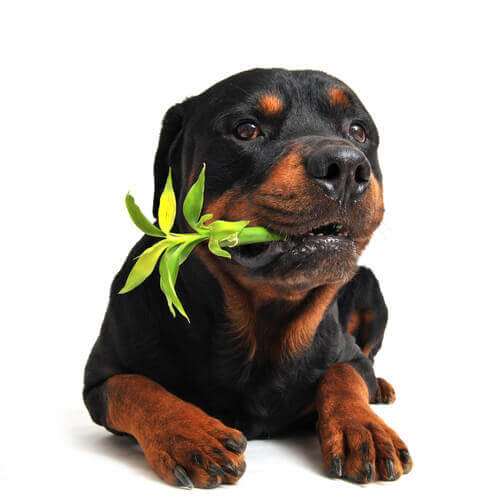Chamomile and Its Medicinal Properties for Pets

In the search for a healthier life, it’s becoming increasingly popular to throw out the processed products and resort to natural remedies wherever possible. But what natural remedies are there for pets? Well, chamomile can be very useful, and today we’ll ask why.
Not all plants that work for humans can be used for pets. For example, tea can increase an animal’s heart rate, which can lead to complications. However, chamomile is great for both humans and animals alike.
Chamomile (Matricaria chamomilla) is one of the oldest medicinal plants around. It’s believed that people were originally drawn by its intense smell, and once people started to use it, its different properties only served to make it more popular.

What can I use chamomile for?
Chamomile is a medicinal plant and has several uses for both humans and animals. Let’s take a look at what you can use it for.
Digestive system
Vets claim that chamomile can be a good way to relieve poor digestion, an inflamed stomach, flatulence, or diarrhea.
This is because it contains apigenin, which is being increasingly studied, because it can be found in a wide variety of medicinal plants and has a range of health benefits.
Nerves and anxiety
If your pet gets easily nervous or scared by things such as rockets, cars, or other loud sounds, chamomile might be a good idea. Once again, apigenin comes to the rescue, producing a calming effect.
Irritated skin
If you ever notice that your pet is suffering from irritated skin, either because of a bite, allergy, or soap product, maybe consider using chamomile.
To do this, prepare an infusion and apply it with compresses to reduce inflammation, pain, and itching.
Eyes
If your pet is suffering from eye irritation or conjunctivitis, chamomile can be an effective way of relieving pain and getting rid of whatever is causing the discomfort. Sock a pad of cotton wool in a chamomile infusion and gently apply it to the eye area.
Worms
A chamomile drink can also be used to get rid of intestinal worms. This is simply a complementary treatment, however. These types of infections require veterinary attention and specific medication.
Ticks
The chamomile scent helps scare away ticks. So, try spraying your pet (during their bath) with a little infusion of warm chamomile and say goodbye to unwanted parasites.
Muscle pains
With the list growing ever longer, it’s no surprise to find that chamomile and the apigenin it contains can also be an effective relief for muscle pains. You can apply it both externally and orally.
- To apply orally, prepare a cup of chamomile infusion (100-125 ml) and give it to your pet.
- To apply externally, use a cotton wool pad soaked in chamomile tea.

How to prepare chamomile tea?
You can find chamomile in sachets in any supermarket, although you can also go to a herbalist and buy it in bags or in bulk. But if you buy in bulk, it would be best to buy dry whole flowers. That way, you can make the most of its properties.
To provide some relief for your pet in any of the situations detailed above, simply prepare an infusion using the plants.
- Put some water on to boil.
- When the water boils, put the flowers in and cover with a lid. Turn off the heat so that you don’t burn the flowers and ruin their medicinal properties.
- Let the infusion sit for a while.
Although humans normally drink teas hot, pets should drink it cold or at the very most only slightly warm.
If your pet is going to drink the infusion, you can add a little honey. But if you want to add anything else, check with your vet first.
If you’re going to apply the preparation externally, soak a compress or some cotton pads in the infusion and apply it to the affected area.

Important things to consider
We should always consult with your vet before using medicinal plants with your pet. Even though chamomile is probably acceptable, it’s worth asking to make sure you use it correctly.
Some animals may be allergic, so you should do a test first:
- Applied externally. Apply a little of the infusion to a specific area of the body (never apply to large areas) and observe the reaction.
- Taken orally. Give your pet a small sip of the infusion and observe their reaction in case of vomiting or any other problem.
It’s very important to mention that drinking chamomile in excessive quantities can be dangerous for pregnant dogs, so limit how much you use it.
In fact, whole chamomile can be poisonous if ingested in large quantities. If your dog eats too much in a field, for example, they may later experience vomiting or diarrhea.
However, if you use an infusion, the dose will obviously be greatly reduced, which is why it’s a much better option. But always check with your vet if you have any doubts or concerns.
All cited sources were thoroughly reviewed by our team to ensure their quality, reliability, currency, and validity. The bibliography of this article was considered reliable and of academic or scientific accuracy.
Manzanilla, Wikipedia. Recogido a 23 de abril en https://es.wikipedia.org/wiki/Matricaria_recutita
Apigenina, The American Journal of Pathology. Recogido a 23 de abril en https://ajp.amjpathol.org/article/S0002-9440(10)62196-7/fulltext
Tóxica, Dialnet. Recogido a 23 de abril en https://dialnet.unirioja.es/servlet/articulo?codigo=3177054
